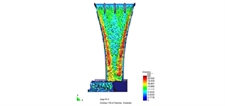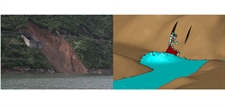LANDSLIDES
LANDSLIDES IN RESERVOIRS
The landslides constitute one the most important natural hazards in the world, because of their frequency of occurrence, and their catastrophic consequences. At the same time, this is a very complex phenomenon, hard to characterize and predict due to its dependence on the terrain characteristics, topography, environmental conditions, etc. Landslides in reservoirs constitute a particular case, because they can be a consequence of the fill up cycles that modify the material characteristics. Furthermore, these events may generate impulse waves which may endanger the dam and the reservoir due to wave run-up, or even overtopping of the dam crest.
Within this research line a proposal (XLIDE) has been presented in collaboration with other research groups in numerical methods (UPM), companies specialized in slope analysis and monitoring (OFITECO), and with the authorities responsible for the management of the infrastructures (Ebro Hydrographic Confederation).
The problem involves several phases: the slide itself, wave formation, wave propagation, and its effects in the slopes and the dam.

Figure 1. Stages of the phenomenon of landslide in a reservoir. Source: Garrote, L. and Laguna, F.: "Generación de olas por deslizamiento". Jornadas Técnicas sobre estabilidad de laderas en embalses. Zaragoza, 2007
So far, some calculations have been done corresponding to a case with available data obtained from physical model tests. This case has been previously studied using other numerical codes. The previous results have been compared with the results obtained with PFEM.
Figure 2: Numerical simulation of Vajont landslide. Water Blue, landslide red.
Figure 3: Numerical simulation of Lituya landslide





